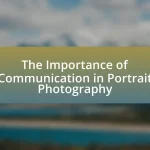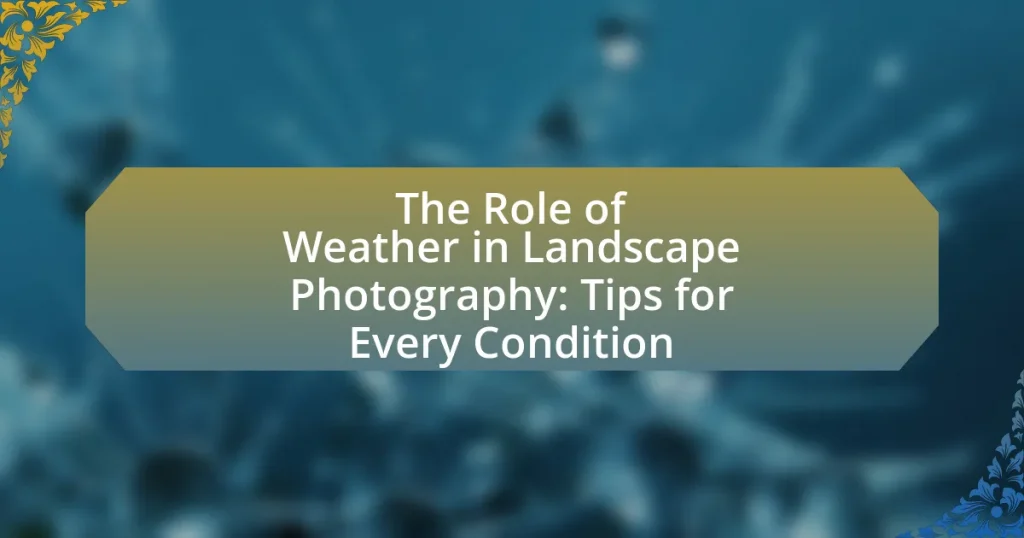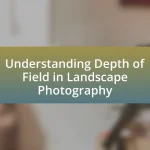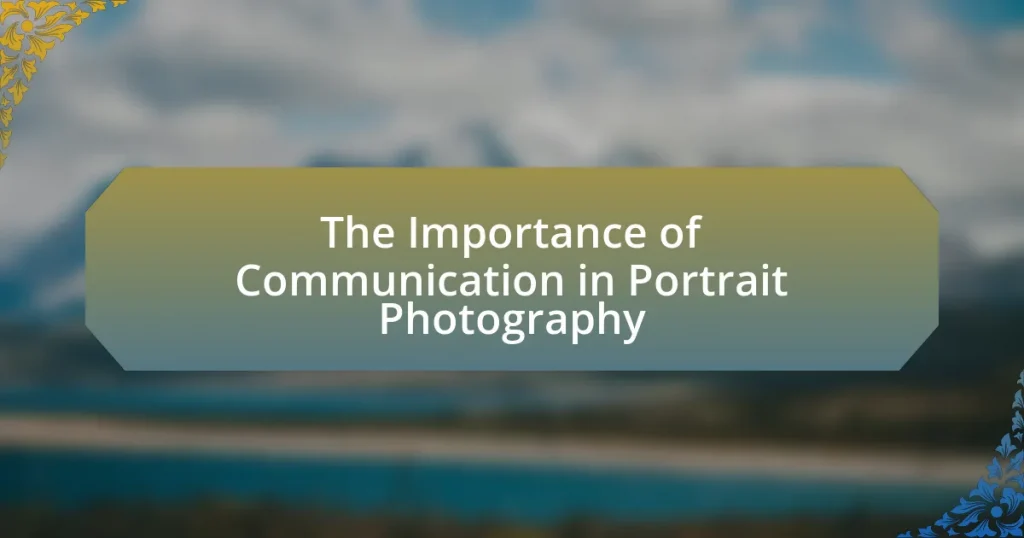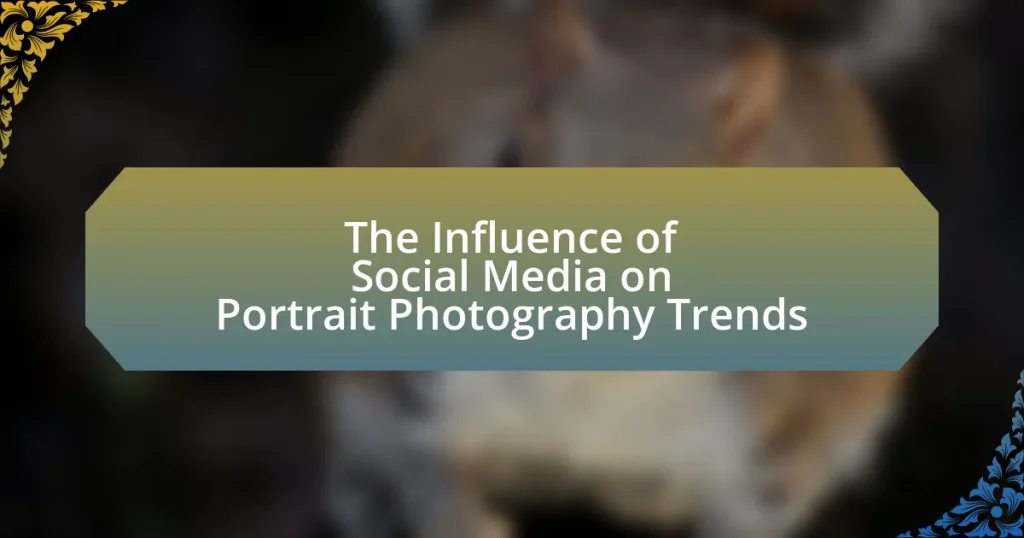The article examines the significant role of weather in landscape photography, detailing how various weather conditions influence lighting, mood, and composition. It highlights the effects of specific weather phenomena, such as golden hour light, overcast skies, storms, and fog, on the visual appeal of photographs. Additionally, the article provides practical tips for photographers on adapting techniques and equipment to different weather scenarios, emphasizing the importance of understanding weather patterns for optimal shooting conditions. Key elements to monitor, such as temperature and humidity, as well as strategies for predicting weather changes, are also discussed to enhance the quality of landscape photography across all conditions.
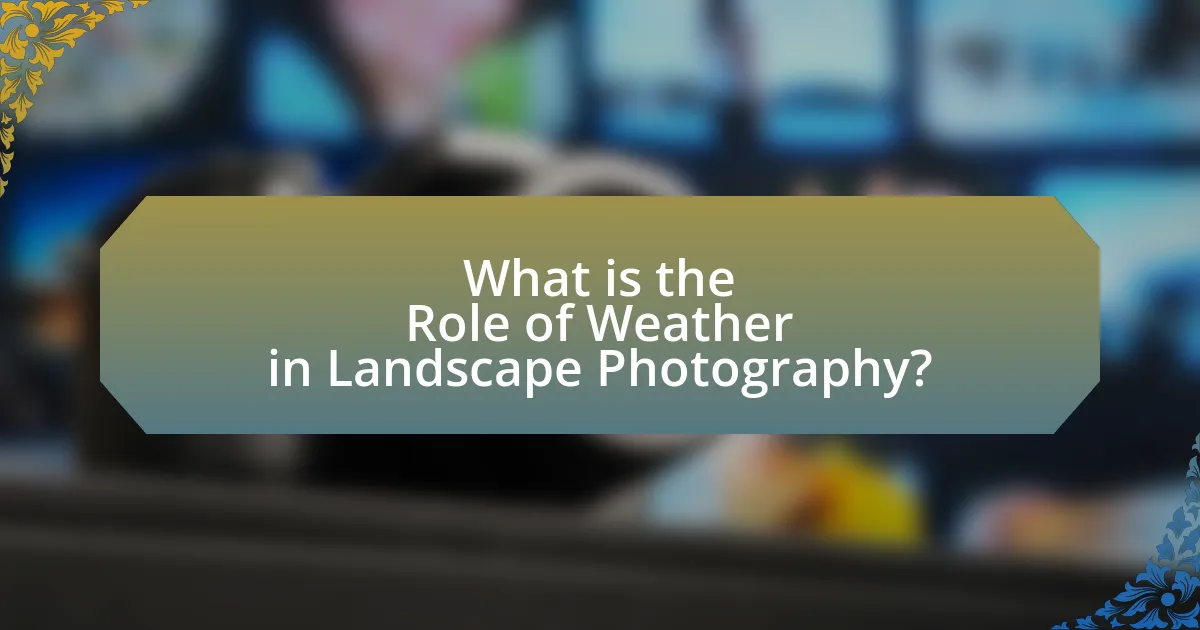
What is the Role of Weather in Landscape Photography?
Weather plays a crucial role in landscape photography by influencing lighting, mood, and the overall composition of images. Different weather conditions, such as clear skies, overcast clouds, rain, or fog, can dramatically alter the appearance of a landscape, affecting colors, contrasts, and textures. For instance, golden hour light during sunrise or sunset creates warm tones and long shadows, enhancing the visual appeal of a scene. Conversely, overcast skies can provide soft, diffused light that reduces harsh shadows, making it ideal for capturing details in foliage or water. Additionally, dramatic weather events like storms can add a sense of drama and urgency to photographs, creating striking images that resonate with viewers.
How does weather influence the mood and atmosphere of landscape photographs?
Weather significantly influences the mood and atmosphere of landscape photographs by altering light conditions, color saturation, and emotional resonance. For instance, overcast skies create soft, diffused lighting that can evoke a sense of calmness, while dramatic storm clouds can impart a feeling of tension or foreboding. Additionally, the presence of rain can enhance colors, making landscapes appear more vibrant, as noted in studies on color theory in photography. Furthermore, different weather conditions can evoke specific emotions; sunny days often convey happiness and warmth, while fog can create a sense of mystery and isolation. Thus, the interplay between weather and photography is crucial in shaping the viewer’s emotional response to the image.
What specific weather conditions create dramatic effects in photography?
Specific weather conditions that create dramatic effects in photography include overcast skies, storms, fog, and golden hour lighting. Overcast skies diffuse sunlight, reducing harsh shadows and enhancing colors, which is ideal for capturing vibrant landscapes. Storms introduce dynamic elements such as lightning and dramatic cloud formations, adding intensity to images. Fog creates a sense of mystery and depth by obscuring distant elements, resulting in ethereal photographs. Golden hour lighting, occurring shortly after sunrise or before sunset, bathes scenes in warm tones, enhancing textures and creating visually striking contrasts. These conditions are widely recognized among photographers for their ability to transform ordinary scenes into captivating images.
How do different times of day and seasons affect weather conditions in photography?
Different times of day and seasons significantly influence weather conditions in photography by altering light quality, color temperature, and atmospheric phenomena. During the golden hour, shortly after sunrise and before sunset, the sunlight is softer and warmer, creating ideal conditions for capturing landscapes with rich colors and long shadows. In contrast, midday light is harsher, resulting in high contrast and less saturated colors, which can be less favorable for photography.
Seasonally, winter often brings clearer skies and unique atmospheric conditions like snow, which can enhance the visual appeal of landscapes. Spring and summer typically feature more dynamic weather patterns, including storms that can produce dramatic skies and vibrant colors, while autumn offers a palette of warm hues due to foliage changes. These variations in light and weather conditions directly impact the mood and aesthetic of photographs, making timing and seasonal awareness crucial for landscape photographers.
Why is understanding weather patterns important for landscape photographers?
Understanding weather patterns is crucial for landscape photographers because it directly influences the quality of light, atmospheric conditions, and the overall mood of a scene. For instance, golden hour lighting occurs shortly after sunrise and before sunset, creating soft, warm tones that enhance landscape images. Additionally, weather phenomena such as fog, rain, or storms can add dramatic elements to photographs, making them more visually compelling. Research indicates that photographers who plan their shoots around weather forecasts can significantly improve their chances of capturing stunning images, as certain conditions can transform a mundane landscape into a breathtaking scene.
What are the key weather elements that photographers should monitor?
Photographers should monitor temperature, humidity, wind speed, cloud cover, and precipitation. Temperature affects equipment performance and subject appearance, while humidity influences atmospheric clarity and detail. Wind speed can impact stability and movement in subjects, particularly in landscapes with foliage or water. Cloud cover is crucial for lighting conditions, as it can diffuse sunlight and create dramatic effects. Precipitation, including rain or snow, can alter the landscape and present unique photographic opportunities. Monitoring these elements allows photographers to optimize their shooting conditions and achieve desired results.
How can photographers predict weather changes for optimal shooting conditions?
Photographers can predict weather changes for optimal shooting conditions by utilizing weather apps, radar systems, and local forecasts. These tools provide real-time data on temperature, humidity, wind speed, and precipitation, which are crucial for planning outdoor shoots. For instance, apps like Weather Underground and AccuWeather offer hyper-local forecasts that can indicate imminent weather changes, allowing photographers to adjust their plans accordingly. Additionally, understanding weather patterns, such as the formation of clouds and the movement of fronts, can enhance a photographer’s ability to anticipate lighting conditions and atmospheric effects, which are vital for capturing stunning landscape images.
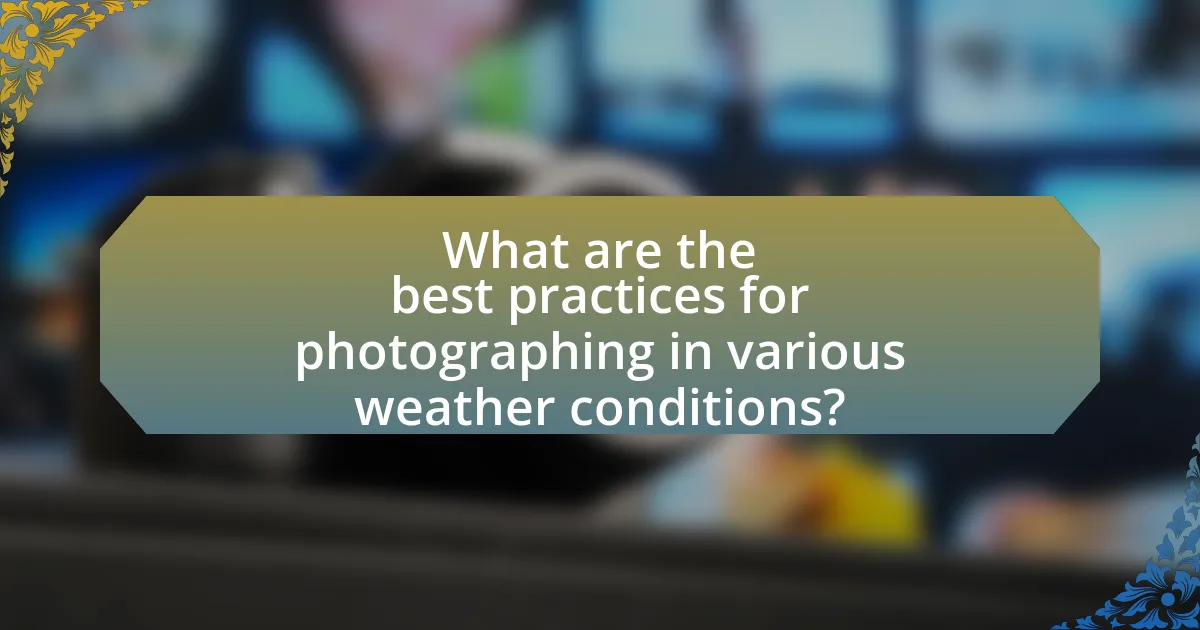
What are the best practices for photographing in various weather conditions?
To photograph effectively in various weather conditions, photographers should adapt their techniques to suit the environment. In sunny conditions, using a polarizing filter can reduce glare and enhance colors, while in overcast weather, soft light can be utilized to capture details without harsh shadows. During rain, waterproof gear protects equipment, and capturing reflections in puddles can add interest to compositions. In snowy conditions, adjusting exposure settings is crucial to avoid underexposure, as snow can trick the camera’s metering system. Windy weather may require stabilizing equipment to prevent motion blur. These practices are supported by the fact that many professional photographers adjust their settings and techniques based on weather conditions to achieve optimal results.
How can photographers adapt their techniques to different weather scenarios?
Photographers can adapt their techniques to different weather scenarios by adjusting their camera settings, composition, and equipment. For instance, in bright sunlight, they may use a polarizing filter to reduce glare and enhance colors, while in low-light conditions, they might increase the ISO and use a tripod to stabilize the camera. During rainy weather, using weather-sealed gear and lens hoods can protect equipment, and capturing reflections in puddles can create interesting compositions. In foggy conditions, photographers can focus on creating mood by emphasizing shapes and silhouettes, while in snowy environments, they should adjust exposure settings to prevent underexposure due to the brightness of the snow. These adaptations are essential for achieving optimal results in varying weather conditions.
What equipment adjustments are necessary for shooting in rain or snow?
To shoot in rain or snow, photographers must use weather-sealed equipment and protective covers. Weather-sealed cameras and lenses prevent moisture from entering sensitive components, ensuring functionality in adverse conditions. Additionally, using lens hoods can help reduce water droplets on the lens surface, while rain covers or plastic bags can protect the entire camera setup. These adjustments are essential as moisture can damage electronic components and affect image quality.
How can lighting conditions be managed during overcast or sunny days?
Lighting conditions can be managed during overcast or sunny days by utilizing specific techniques tailored to each scenario. On overcast days, photographers should take advantage of the soft, diffused light that reduces harsh shadows, making it ideal for capturing details and colors in landscapes. Using a tripod can help stabilize the camera for longer exposures, which is beneficial in lower light conditions.
Conversely, on sunny days, managing lighting involves using filters, such as polarizers, to reduce glare and enhance colors. Photographers can also shoot during the golden hours—shortly after sunrise or before sunset—when the light is softer and warmer. Additionally, employing reflectors can help bounce light into shadowed areas, ensuring a more balanced exposure throughout the scene.
These methods are supported by the understanding that light quality significantly impacts the visual outcome in photography, as noted in various photography guides and studies.
What tips can enhance landscape photography in challenging weather?
To enhance landscape photography in challenging weather, photographers should utilize appropriate gear, adjust camera settings, and embrace the unique conditions. Using weather-sealed equipment protects against rain and moisture, while a sturdy tripod stabilizes shots in windy conditions. Adjusting settings, such as increasing ISO for low light or using a slower shutter speed to capture movement in clouds or water, can yield dynamic images. Embracing the weather, such as capturing dramatic skies during storms or the soft light after rain, can lead to striking compositions. Studies show that diverse weather conditions can enhance the emotional impact of landscape images, making them more compelling to viewers.
How can photographers utilize fog and mist to create ethereal images?
Photographers can utilize fog and mist to create ethereal images by incorporating the soft, diffused light and reduced visibility that these weather conditions provide. Fog and mist act as natural filters, softening harsh contrasts and creating a dreamlike atmosphere that enhances the mood of the photograph. This effect can be particularly striking in landscape photography, where the obscured details can lead to a sense of mystery and depth. For instance, the presence of fog can simplify a scene by masking distracting elements, allowing the viewer to focus on shapes and forms rather than intricate details. Additionally, fog can enhance color saturation, making hues appear more vibrant, which contributes to the overall ethereal quality of the image.
What strategies can be employed to capture vibrant colors during sunset or sunrise?
To capture vibrant colors during sunset or sunrise, photographers should utilize techniques such as adjusting the white balance to ‘cloudy’ or ‘shade’ settings, which enhances warm tones. Additionally, using a polarizing filter can reduce glare and saturate colors, making the hues more vivid. Shooting in RAW format allows for greater flexibility in post-processing, enabling adjustments to exposure and color balance without losing quality. Research indicates that the golden hour, occurring shortly after sunrise and before sunset, provides optimal lighting conditions, resulting in richer colors due to the angle of sunlight.

How can photographers prepare for unpredictable weather conditions?
Photographers can prepare for unpredictable weather conditions by utilizing weather apps and forecasts to stay informed about changing conditions. These tools provide real-time updates on temperature, precipitation, and wind, allowing photographers to adjust their plans accordingly. For instance, the Weather Channel app offers hourly forecasts and radar maps, which can help photographers decide when to shoot or seek shelter. Additionally, carrying protective gear such as waterproof camera bags and lens covers ensures that equipment remains safe from rain or moisture. This preparation is crucial, as studies show that weather can significantly impact the quality of landscape photography, with dramatic skies often enhancing visual appeal.
What essential gear should photographers carry for varying weather conditions?
Photographers should carry weather-resistant gear, including waterproof camera bags, lens covers, and protective filters, to adapt to varying weather conditions. Waterproof camera bags safeguard equipment from rain and moisture, while lens covers prevent water droplets from affecting image quality. Protective filters, such as UV or polarizing filters, can shield lenses from dust and scratches, ensuring clarity in diverse environments. Additionally, carrying extra batteries is crucial, as cold weather can deplete battery life quickly. These items collectively enhance a photographer’s ability to capture high-quality images regardless of the weather.
How can protective gear safeguard equipment from harsh weather?
Protective gear can safeguard equipment from harsh weather by providing a barrier against elements such as rain, snow, dust, and extreme temperatures. This gear, which includes waterproof cases, lens hoods, and weather-resistant bags, prevents moisture and debris from damaging sensitive components, ensuring functionality and longevity. For instance, waterproof cases can keep cameras dry during heavy rain, while insulated bags can protect batteries from freezing temperatures, which can reduce their performance.
What are the benefits of using weather apps for photographers?
Weather apps provide photographers with real-time data on conditions such as temperature, humidity, wind speed, and precipitation, which are crucial for planning outdoor shoots. By utilizing these apps, photographers can select optimal times for capturing images, ensuring they take advantage of favorable lighting and weather conditions. For instance, knowing when a storm is approaching can help photographers prepare for dramatic skies or avoid being caught in adverse weather. Additionally, many weather apps offer radar and satellite imagery, allowing photographers to visualize cloud cover and weather patterns, which can enhance the composition of their shots. This data-driven approach increases the likelihood of capturing high-quality images that align with the photographer’s creative vision.
What are common mistakes to avoid when shooting in adverse weather?
Common mistakes to avoid when shooting in adverse weather include neglecting proper gear protection, failing to adjust camera settings for changing light conditions, and overlooking safety precautions. Photographers often forget to use weather-sealed equipment or protective covers, which can lead to damage from rain or snow. Additionally, not adjusting ISO, shutter speed, and aperture settings can result in poorly exposed images due to fluctuating light. Safety is also crucial; photographers may underestimate the risks of slippery surfaces or strong winds, which can lead to accidents. These mistakes can significantly impact the quality of the photographs and the safety of the photographer.
How can photographers ensure safety while shooting in extreme conditions?
Photographers can ensure safety while shooting in extreme conditions by conducting thorough research on the environment, using appropriate gear, and having a solid emergency plan. Researching weather forecasts and terrain conditions helps photographers anticipate hazards such as storms or extreme temperatures. Utilizing specialized equipment, such as weather-resistant cameras and protective clothing, minimizes risks associated with exposure to harsh elements. Additionally, having an emergency plan, including communication devices and knowledge of evacuation routes, is crucial for responding effectively to unforeseen situations. These practices are supported by safety guidelines from organizations like the Outdoor Industry Association, which emphasize preparedness in outdoor activities.
What are the pitfalls of not being prepared for sudden weather changes?
Not being prepared for sudden weather changes can lead to significant challenges in landscape photography, including missed opportunities for capturing ideal shots and potential safety hazards. Photographers may find themselves unprotected from elements like rain, snow, or extreme temperatures, which can damage equipment and affect personal safety. For instance, a study by the National Oceanic and Atmospheric Administration (NOAA) highlights that sudden weather shifts can result in hazardous conditions, increasing the risk of accidents in outdoor settings. Additionally, unanticipated weather can alter lighting conditions, making it difficult to achieve desired photographic effects, ultimately impacting the quality of the images captured.
What practical tips can improve landscape photography across all weather conditions?
To improve landscape photography across all weather conditions, photographers should focus on utilizing the unique characteristics of each weather scenario. For instance, during overcast days, soft light reduces harsh shadows, making it ideal for capturing details in landscapes. In contrast, golden hour light, found during sunrise and sunset, enhances colors and textures, providing dramatic effects.
Additionally, using a tripod stabilizes the camera in windy conditions, ensuring sharp images, while employing filters, such as polarizers, can reduce glare and enhance color saturation in bright conditions. Understanding weather patterns allows photographers to anticipate changes, enabling them to be in the right place at the right time for optimal lighting.
Research indicates that varying weather conditions can significantly affect the mood and composition of landscape photographs, as noted in studies on visual perception in photography. By adapting techniques to suit the weather, photographers can consistently capture compelling images regardless of environmental challenges.
